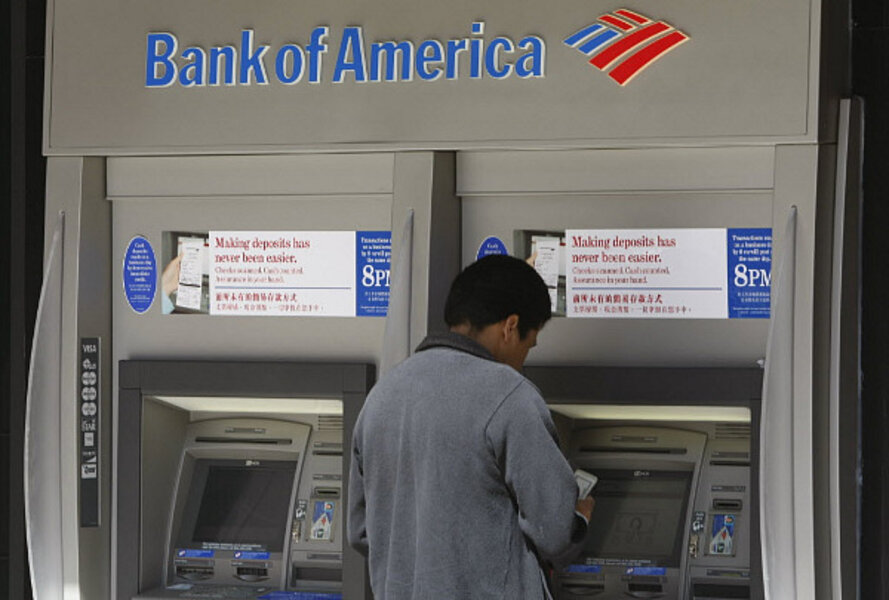Dow index falls as big banks make money but not new loans
Loading...
American banks see their health improving, yet the progress so far isn't resulting in big flows of credit to the struggling US economy. That news helped to push stock prices sharply lower Friday.
It's a glass half-full and half-empty story. But even "half full" isn't necessarily good news when it comes to the financial sector, which affects virtually every Main Street in the nation.
Two of the four largest commercial banks reported earnings Friday, with Citigroup unveiling a $2.7 billion quarterly profit and Bank of America citing earnings of $3.1 billion. Both big banks said worries about loan defaults are starting to ease. Yet their stock prices fell, in part because they reported a slow business climate in which their loan portfolios are shrinking.
A dearth of lending could be a problem for the banks in the future, because it's hard to grow profits if revenues from loans are falling. But it also may signal trouble for the wider economy, because periods of recovery usually see a positive turn in the flow of credit.
The decline in bank stocks was paralleled by a wider decline in the overall stock market Friday.
Sagging consumer confidence
The Dow Jones Industrial Average lost 2.5 percent during the day's trading. The bank news came alongside reports of sagging consumer confidence and deflation pressure in consumer prices. Bank of America shares fell about 9 percent Friday, and Citigroup 6 percent. JPMorgan Chase also lost value after reporting $4.8 billion in earnings on Thursday.
"This is the first instance of an outright contraction in private ... credit" in 60 years of government records, economist Paul Kasriel of the Northern Trust Co. writes in a recent economic analysis. In past recessions, credit growth has slowed but not turned negative.
What's behind the drop, in addition to weak demand from recession-battered consumers and businesses, may be two factors, Mr. Kasriel says.
First, they still have more losses ahead on real estate loans. Second, they expect that capital requirements – the cushion that banks hold against the risk of loan losses – will rise as regulators try to prevent future financial crises. In both cases, the result could be that a capital level that's adequate today might become inadequate tomorrow.
Thus, emergency easing of monetary conditions by the Federal Reserve (zero percent interest rates on overnight loans to banks) has not transmitted much fuel through banks to the wider economy. Now, President Obama is about to sign a major financial reform bill designed to tighten oversight of banks. Many economists say the bill is needed, but critics worry that short-term effects could hamper lending.
Brian Moynihan, chief executive of Bank of America, cited several of these concerns in a conference call to announce the bank's earnings.
He said the bank is trying to "get ahead" of looming capital requirements, and that demand for new loans is weak. "We're well aware of the headwinds we're going to continue to face," he said.
Real estate crisis far from over
One headwind: The real estate crisis is far from over. Banks could be stuck with 6 million homes in the next two years due to mortgage defaults, according to an estimate by John Burns Real Estate Consulting in Irvine, Calif.
Despite the tough times, the situation isn't that banks have ceased to make any new loans. But on balance, the size of their loan books has been declining.
The big question is how much these conditions – both in credit supply and demand – are hampering growth and whether they will soon shift. It's a subtle question, because adverse circumstances are forcing many households to deleverage, or reduce their outstanding debt. Even so, many economists say some improvement in the flow of credit should accompany the recovery. That may be starting to occur.
Although the quantity of loans is declining, it is occurring at a slower pace, according to some Federal Reserve data. Loans and leases (including business, real estate, and consumer loans) declined at a 4.7 percent annualized pace in June, compared with a 7.5 percent pace of decline for the whole second quarter. In the first quarter the pace of decline was 10.7 percent, coming off a 10.2 percent decline for all of 2009.
The signs of halting progress for US banks come as European banks are facing their own scrutiny, regarding exposure to bad loans and debts of at-risk nations such as Greece. Results of a so-called "stress test," similar to a regulatory review of large US banks in 2009, are set to be unveiled next week.
International Monetary Fund chief Dominique Strauss-Kahn predicted in a TV interview that the results will be "rather reassuring," Reuters reported.
Related:
As Consumer Price Index falls for third month, deflation risk emerges





